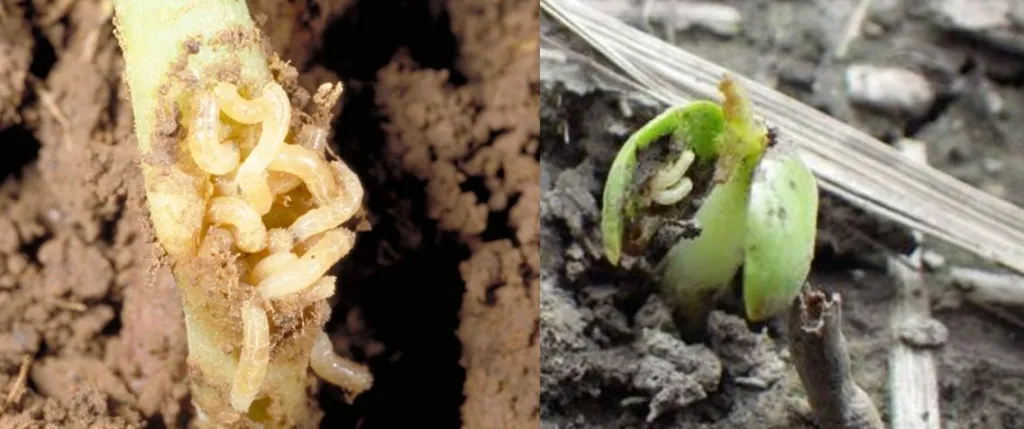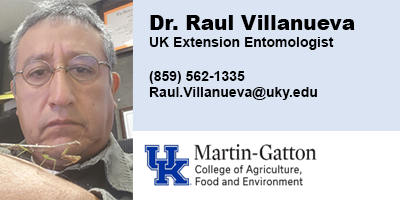Monitoring of Seedcorn Maggot May Be Required During Planting & Germination
Monitoring of Seedcorn Maggot May Be Required During Planting & Germination

Seedcorn Maggot
The seedcorn maggot, Delia platura (Diptera: Anthomyiidae), is the larval stage of a small fly that feeds on seeds of corn, soybean, cereals, brassicae (such as broccoli, Figure 1), and various allium crops (such as garlic, onion, and lilies). The seedcorn maggots are detritivores, meaning they feed on decomposing organic matter, and they often target germinating seeds of the aforementioned crops. Seedcorn maggots overwinter as pupae, with the first generation of adults emerging early in the growing season to mate and lay eggs.
Seedcorn larvae can feed on cotyledons, embryos, and endosperms of germinating seeds, potentially killing seedlings or delaying their development. Early planting often coincides with the emergence of the first generation of maggots, increasing the risk of significant damage to germinating maize and soybean crops. Outbreaks of seedcorn maggots can result in stand losses exceeding 90%. High soil moisture and low temperatures further exacerbate the issue by slowing seed germination, making seeds more vulnerable to seedcorn maggot attack.
Current Sowing Situation
Corn and soybean farmers in Kentucky have been postponing sowing their seeds in 2025. One of the reasons for this delay is the high soil moisture caused by cumulative precipitation levels, which are significantly higher compared to previous years. Figure 2 shows the cumulative precipitation in four Kentucky cities -Mayfield, Princeton, Bowling Green, and Lexington- located in four counties from west to east (Graves, Caldwell, Warren, and Fayette, respectively) from January 1 to May 3, for the years 2020, 2024, and 2025. These years represent “normal,” dry, and high-precipitation conditions, respectively. The cumulative data presented here were summarized from the UK Ag Weather Center.

Figure 2. Cumulated precipitation (inches) in 2020 (“normal” rainfall year), 2024 (dry year), and 2025 (wet year) in Mayfield, Princeton, Bowling Green, and Lexington located in Graves, Caldwell, Warren, and Fayette counties (map inset shows county locations).
Compared to 2020 (a “normal” year), cumulative precipitation in 2024 (a dry year) was 28%, 36%, 25%, and 9% lower, whereas in 2025 (a wet year), cumulative precipitation was 53%, 62%, 24%, and 31% higher for Mayfield, Princeton, Bowling Green, and Lexington, respectively (Figure 3).

Moist soils and heavy rains can affect the longevity of seed treatments, increase the risk of fungal diseases, wash away fertilizers or herbicides, and promote the proliferation of insects and mollusks. The entomology lab in Princeton is closely monitoring snail and slug populations; so far, these populations have not surged in Western KY, but this week (05/08/25), Colby Guffey the County Extension Agent, Agriculture and Natural Resources of Clinton County reported and outbreak of slugs in soybeans in Wayne County (Figure 4), reporting a 23.9 ± 8.4 (mean ± SEM) and highest count of 50 snail per 5 sq-ft.
Soybean and corn growers should remain alert, as high soil moisture can also increase the activity of seed corn maggots and mollusks.

Management
Scouting for seedcorn maggots should be conducted during the germination stage of maize and soybeans. If plants appear damaged during the cotyledon stage, dig around the seedlings to check for the presence of maggots. Symptoms such as yellowing leaves or stunted growth may also indicate seedcorn maggot infestation.
There are no rescue treatments available for seedcorn maggots. Therefore, preventative measures are essential. These may include the use of insecticide-treated seeds or in-furrow insecticides in fields at high risk for infestation. If heavy losses occur, replanting may be necessary.
Cultural control strategies include:
- Planting when environmental conditions favor rapid seed germination and seedling growth.
- Avoiding planting for at least two weeks after incorporating fresh organic matter into the soil.
- Prompt replanting with treated seed to improve stand establishment.
More Information
- Seedcorn Maggot, University of Minnesota
- Seedcorn Maggots (ENTFACT-309), University of Kentucky
- Seedcorn Maggots Get an Early Start, Iowa State University
- Seedcorn Maggot Seen in Abundant Numbers in Corn and Soybeans, Kentucky Pest News, University of Kentucky

